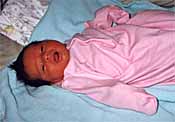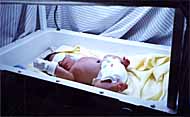What is
kernicterus?
Kernicterus is a type of brain damage that causes athetoid cerebral palsy and hearing loss. It also causes problems with vision and teeth and sometimes can cause mental retardation. In some newborn babies, the liver makes too much yellow pigment called bilirubin. When too much bilirubin builds up in a new baby's body, the skin and whites of the eyes turn yellow. This yellow coloring is called jaundice. Jaundice is very common in newborn babies and usually goes away by itself. A little jaundice is not a problem, but a few babies have too much jaundice. If not treated, high levels of bilirubin can damage the brain.
Who can develop
kernicterus?
Any baby with untreated jaundice is at risk for kernicterus. This does not mean that every baby with yellow skin will have brain damage. Most babies with jaundice get better by themselves. If their skin is very yellow, they might need phototherapy treatment. If phototherapy does not lower the baby's bilirubin levels, the baby may need an exchange transfusion.
 Does jaundice always cause a problem?
Does jaundice always cause a problem?
Many babies have some jaundice. When they are a few days old, their skin slowly begins to turn yellow. The yellow color comes from the color of bilirubin. When red blood cells die, they break down and bilirubin is left. It is normal for some of the red blood cells to die everyday. The red blood cells break down and make bilirubin. In newborns, the liver may not be developed enough to get rid of so much bilirubin at once. So, if too many red blood cells die at the same time, the baby can become very yellow or may even look orange. The yellow color does not hurt the baby's skin, but the bilirubin goes to the brain as well as to the skin. That can lead to brain damage.
Are some babies more likely to be jaundiced?
Many babies have jaundice. Some babies are more likely to have jaundice than others.
Sibling
If the baby has a brother or sister that had jaundice, the newborn will probably have jaundice.
Bruising
A baby who has bruises at birth is likely to have jaundice. A bruise forms because blood leaked out of a blood vessel and caused the skin to look black and blue. Then, when the bruise begins to heal, red blood cells die. Bilirubin is made when red blood cells break down. The healing of large bruises may cause high levels of bilirubin and the baby may become jaundiced.
Preterm babies
Babies born before 37 weeks, or 8 ½ months, of pregnancy may become jaundiced because their liver may not be fully developed. The immature liver may not be able
to get rid of so much bilirubin. So, if too many red blood cells break down at the same time, the baby can become very yellow or may even look orange.
Feeding
Babies who do not eat much are more likely to get jaundice.
Early jaundice
A baby who is yellow in the first 24 hours of life may get dangerously jaundiced.
Heredity
A baby born to an East Asian or Mediterranean family is at a higher risk of becoming very jaundiced. Also, jaundice is harder to see in babies with darker skin tones. Some families inherit a G6PD problem, and their babies are more likely to become jaundiced.
Additional questions and answers about jaundice:
American Academy of
Pediatrics Question and Answers: Jaundice and Your Newborn
What are some warning signs of
kernicterus?
-
Very yellow or orange skin tones (beginning at the head and spreading to the toes)
-
Increased sleepiness, so much that it is hard to wake the baby
-
The baby is not as alert and awake
-
High-pitched cry
-
Poor sucking or nursing
-
Weakness, limpness, or floppiness
-
The baby's body is arched like a bow (the head and heels are bent backward and the body forward)
 Can jaundice be treated and prevent kernicterus from developing?
Can jaundice be treated and prevent kernicterus from developing?
No baby should develop brain damage from untreated jaundice. If a baby gets too jaundiced, the baby can be treated with phototherapy. That is, the baby can be put under blue lights most of the day. The blue lights do not bother the baby. They are warm and probably feel good. If the baby gets very, very jaundiced, the doctor can do an exchange transfusion.
What should I do if I think my baby has jaundice?
Call and visit your baby's doctor right away.
Is there a support group for parents of children with kernicterus?
Yes. Parents
of Infants and Children of Kernicterus

[Return to Top of Page]
Date: November 8, 2005
Content source: National Center on Birth Defects and Developmental
Disabilities